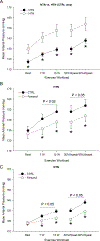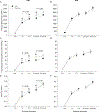Exercise Pressor Reflex Contributes to the Cardiovascular Abnormalities Characterizing: Hypertensive Humans During Exercise
- PMID: 31607174
- PMCID: PMC6854322
- DOI: 10.1161/HYPERTENSIONAHA.119.13366
Exercise Pressor Reflex Contributes to the Cardiovascular Abnormalities Characterizing: Hypertensive Humans During Exercise
Abstract
We investigated the impact of hypertension on circulatory responses to exercise and the role of the exercise pressor reflex in determining the cardiovascular abnormalities characterizing patients with hypertension. After a 7-day drug washout, 8 hypertensive (mean arterial pressure [MAP] 130±4 mm Hg; 65±3 years) and 8 normotensive (MAP 117±2 mm Hg; 65±2 years) individuals performed single-leg knee-extensor exercise (7 W, 15 W, 50%, 80%-Wpeak) under control conditions and with lumbar intrathecal fentanyl impairing feedback from µ-opioid receptor-sensitive leg muscle afferents. Femoral artery blood flow (QL), MAP (femoral artery), leg vascular conductance, and changes in cardiac output were continuously measured. While the increase in MAP from rest to control exercise was significantly greater in hypertension compared with normotension, the exercise-induced increase in cardiac output was comparable between groups, and QL and leg vascular conductance responses were ≈18% and ≈32% lower in the hypertensive patients (P<0.05). The blockade-induced decreases in MAP were significantly larger during exercise in hypertensive (≈11 mm Hg) compared with normotensive (≈6 mm Hg). Afferent blockade attenuated the central hemodynamic response to exercise similarly in both groups resulting in a ≈15% lower cardiac output at each workload. With no effect in normotensive, afferent blockade significantly raised the peripheral hemodynamic response to exercise in hypertensive, resulting in ≈14% and ≈23% higher QL and leg vascular conductance during exercise. Finally, QL and MAP during fentanyl-exercise in hypertensive were comparable to that of normotensive under control conditions (P>0.2). These findings suggest that exercise pressor reflex abnormalities largely account for the exaggerated MAP response and the impaired peripheral hemodynamics during exercise in hypertension.
Keywords: blood pressure; cardiovascular disease; exercise; hypertension; reflex.
Conflict of interest statement
Conflict of interest
The authors declare no conflict of interest
Figures



References
-
- Lund-Johansen P Twenty-year follow-up of hemodynamics in essential hypertension during rest and exercise. Hypertension. 1991;18:III54–61 - PubMed
-
- Kokkinos PF, Andreas PE, Coutoulakis E, Colleran JA, Narayan P, Dotson CO, Choucair W, Farmer C, Fernhall B. Determinants of exercise blood pressure response in normotensive and hypertensive women: Role of cardiorespiratory fitness. J Cardiopulm Rehabil. 2002;22:178–183 - PubMed

